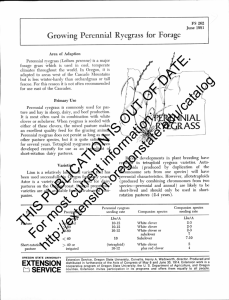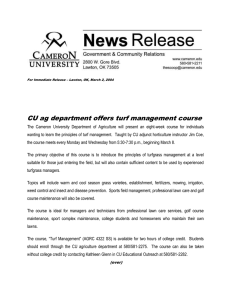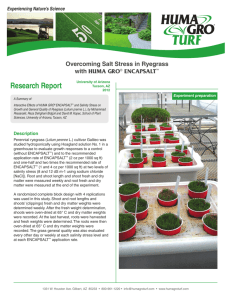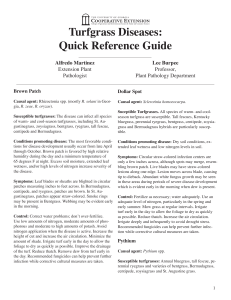Ryegrass Germplasm Overseeding Trials University of Arizona Abstract
advertisement
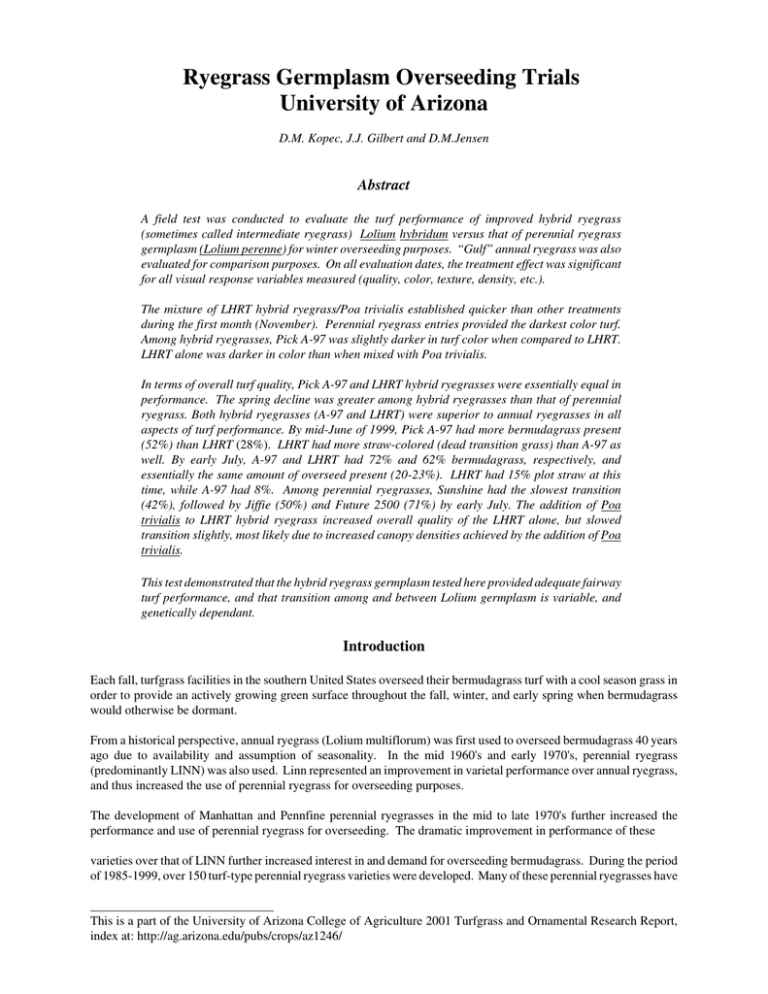
Ryegrass Germplasm Overseeding Trials University of Arizona D.M. Kopec, J.J. Gilbert and D.M.Jensen Abstract A field test was conducted to evaluate the turf performance of improved hybrid ryegrass (sometimes called intermediate ryegrass) Lolium hybridum versus that of perennial ryegrass germplasm (Lolium perenne) for winter overseeding purposes. “Gulf” annual ryegrass was also evaluated for comparison purposes. On all evaluation dates, the treatment effect was significant for all visual response variables measured (quality, color, texture, density, etc.). The mixture of LHRT hybrid ryegrass/Poa trivialis established quicker than other treatments during the first month (November). Perennial ryegrass entries provided the darkest color turf. Among hybrid ryegrasses, Pick A-97 was slightly darker in turf color when compared to LHRT. LHRT alone was darker in color than when mixed with Poa trivialis. In terms of overall turf quality, Pick A-97 and LHRT hybrid ryegrasses were essentially equal in performance. The spring decline was greater among hybrid ryegrasses than that of perennial ryegrass. Both hybrid ryegrasses (A-97 and LHRT) were superior to annual ryegrasses in all aspects of turf performance. By mid-June of 1999, Pick A-97 had more bermudagrass present (52%) than LHRT (28%). LHRT had more straw-colored (dead transition grass) than A-97 as well. By early July, A-97 and LHRT had 72% and 62% bermudagrass, respectively, and essentially the same amount of overseed present (20-23%). LHRT had 15% plot straw at this time, while A-97 had 8%. Among perennial ryegrasses, Sunshine had the slowest transition (42%), followed by Jiffie (50%) and Future 2500 (71%) by early July. The addition of Poa trivialis to LHRT hybrid ryegrass increased overall quality of the LHRT alone, but slowed transition slightly, most likely due to increased canopy densities achieved by the addition of Poa trivialis. This test demonstrated that the hybrid ryegrass germplasm tested here provided adequate fairway turf performance, and that transition among and between Lolium germplasm is variable, and genetically dependant. Introduction Each fall, turfgrass facilities in the southern United States overseed their bermudagrass turf with a cool season grass in order to provide an actively growing green surface throughout the fall, winter, and early spring when bermudagrass would otherwise be dormant. From a historical perspective, annual ryegrass (Lolium multiflorum) was first used to overseed bermudagrass 40 years ago due to availability and assumption of seasonality. In the mid 1960's and early 1970's, perennial ryegrass (predominantly LINN) was also used. Linn represented an improvement in varietal performance over annual ryegrass, and thus increased the use of perennial ryegrass for overseeding purposes. The development of Manhattan and Pennfine perennial ryegrasses in the mid to late 1970's further increased the performance and use of perennial ryegrass for overseeding. The dramatic improvement in performance of these varieties over that of LINN further increased interest in and demand for overseeding bermudagrass. During the period of 1985-1999, over 150 turf-type perennial ryegrass varieties were developed. Many of these perennial ryegrasses have _____________________________ This is a part of the University of Arizona College of Agriculture 2001 Turfgrass and Ornamental Research Report, index at: http://ag.arizona.edu/pubs/crops/az1246/ improved shoot density, persistence under close and frequent mowing, and enhanced disease tolerance. Many also have greatly improved heat tolerance. While these attributes have greatly improved overseed performance, they have adversely affected the spring transition from ryegrass back to bermuda. Ideally, an overseed grass should 1) germinate and emerge quickly, 2) tolerate a wide array of mowing height possibilities, 3) hold color and shoot density in winter weather, and 4) provide a graceful and relatively easy transition to bermudagrass in the spring. A test was conducted in the Karsten Turfgrass Research Facility in Tucson, Arizona, which included: 1) annual ryegrass, 2) two synthetic populations of hybrid ryegrasses, 3) two perennial ryegrasses, and 4) a mixture of hybrid ryegrass/Poa trivialis. Materials and Methods Seven seeded entries were planted onto Tifway bermudagrass on November 2, 1998. The Tifway was mowed 3 times weekly at 0.75 inches. The turf was scalped in eight passes, from 3/4"-3/8" using a reel mower. All clippings were removed as caught. A final pass with a rotary mower was used with bag in place to remove final plant debris. The turf was not verticut. All seven entries were sown using hand shakers made from 2 quart steel cans with holes drilled at the bottom. Plots were seeded in 3 directions, and then topdressed with 1/4" of composted steer manure. Each entry appeared three times in a randomized complete block design. The test was irrigated at 80% Reference E.T. from an onsite weather station. The turf was mowed 3 times a week at 11/16" with a walk behind reel mower. Throughout the season, plots received visual scores for establishment, turfgrass color, quality, density, and texture, as well as plot composition and quality for spring/summer transitions. Data was subjected to the analysis of variance technique using SAS software. An LSD value was calculated as the mean separation statistic and was used only if the “treatment” effect was significant at P=0.05, or less. Single orthogonal polynomial contrasts were used to compare significance of performance differences between two hybrid ryegrasses (LHRT-INTERMEDIATE and PICK A-97) versus annual ryegrass (GULF). An additional contrast was used to compare significance of the response of the two intermediate ryegrasses mentioned above, versus the average performance of 3 perennial ryegrasses (Sunshine, Jiffie, and Future 2500). Lastly, a single contrast was used to compare significance of response of LHRT-Intermediate vs. LHRT when seeded as a mixture with Poa trivialis. The seven entries and seed rate information are included in Appendix Table 1a. Results and Discussion On all dates of evaluation, the “treatment effect” (overseeding entry of the grasses tested) was significant at P=0.05 or less. This demonstrates that there were very different responses among the turfgrass types, which did not occur by chance alone. Turf Establishment: The percent of the entire turfgrass plot that had green grass was estimated by using visual ratings on November 20 and December 15, 1999. On November 20, mean percent plot green scores ranged from 20% to 52% (Table 6). The mixture of LHRT intermediate and Poa trivialis had the largest amount of cover (52%), followed by LHRT (42%) and Gulf annual ryegrass (39%). The intermediate A-97 was slow (20%), along with the true perennial ryegrass entries of Sunshine, Jiffie, and Futura (Table 6). Percent plot green cover increased dramatically by December 15, as mean treatment scores ranged from 68-92% green grass cover among overseeded turfs (Table 6). Gulf annual ryegrass had the least cover of 68%. Sunshine PR and the LHRT/Darkhorse mixture had 87%-92% plot cover, respectively. The contrast of “both intermediates versus the three perennials” was significant. The perennial ryegrasses had on average 81% cover versus 76% ground cover for both intermediates, on average (Table 6). Winter Performance: Color quality scores were assigned to plots on December 15, January 12, and February 24 (Table 1). Density, uniformity, and texture were rated for three, two, and three months, respectively, from January to March (Tables 3, 4, 5). Color scores were highest in December, January, and February for Sunshine and Jiffie perennial ryegrasses. Pick A-97 was also quite dark in January, as were the two perennial ryegrasses Sunshine and Jiffie (7.3). In February, LHRT and A-97 had equal color scores (6.3) while Jiffie and Sunshine scored respective values of 7.7 and 8.0 (Table 1). In December, the LHRT/Darkhorse PT mixture was lighter in color than LHRT intermediate alone (4.7 and 5.7, respectively). The contrast for this comparison was highly significant. The same was true in January (LHRT=6.0; LHRT/Darkhorse=5.0) and again in February (LHRT=6.3; LHRT/Darkhorse=5.3). LHRT was significantly darker than A-97 in January, but not in December or February (Table 1). In February, Gulf annual ryegrass was very light in color (3.3), with significantly lower color scores than LHRT and A-97, alone or when the two intermediate ryegrasses were averaged together. Sunshine and Jiffie perennial ryegrasses had the darkest color turf for winter (with scores of 8.0 and 7.7, respectively) in February (Table 1). Mean turfgrass quality scores in December ranged from 4.0 to 7.3 among overseeded turf. The non-overseeded bermudagrass scored 1.7. For the months of December and January, the mixture of LHRT/Darkhorse had the best quality turf. This was due to the additions of Poa trivialis, which adds fine texture and a smooth appearance to the overall turf (Table 2). By February, LHRT intermediate ranked second for overall turf quality, surpassed numerically in rank only by Sunshine PR. These grasses had mean quality scores of 6.7 and 7.7, respectively. Gulf Annual ryegrass was already showing poor quality evidenced by uneven leaf width, a grainy appearance, and poor tolerance to mowing at 17/64" (Table 2). For the winter period, LHRT/Darkhorse produced a visibly dense turf (8.3) in January. By February, Sunshine PR produced a dense turf (7.3, followed by Jiffie and Futura 2500, both with mean density scores of 6.7). All other overseeded turfs had mean density scores of 6.0 or greater, with the exception of Gulf annual ryegrass (4.3), (Table 3). In December, the LHRT/Darkhorse mixture was significantly denser than LHRT above, and all three perennial ryegrasses were significantly denser (on average) than intermediate LHRT and A-97. For February, no contrast comparisons were significant (Table 3). Winter texture scores were assigned to plots in January, February, and March. Texture is a visual estimate of average relative leaf width. Higher scores represent a finer leaf texture (narrow leaves). In January, the mixture of LHRT/Darkhorse had a very fine appearance for leaf texture (9.0) due to the Poa trivialis component. This decreased in February and March as the intermediate component (LHRT) and/or wider leaf texture of both components became more apparent (Table 5). Both the perennial ryegrass varieties of Sunshine and Jiffie produced fine turf (high texture scores) in February and March. Gulf annual ryegrass exhibited very wide leaf blades in comparison to all other turfs. In December, the LHRT/Darkhorse mixture had significantly higher mean texture scores than LHRT alone, and all three perennial ryegrasses had higher mean texture scores than both intermediates, on average. In February and March, leaf texture varied significantly in LHRT and Gulf. In both February and March, A-97 and LHRT intermediate ryegrasses differed. LHRT’s texture was better in February, while A-97's was better in March (Table 5). Turfgrass uniformity is a visual measure of plot smoothness and plot consistency for color and leaf texture throughout the plot. For February and March, Sunshine, Jiffie, Futura 2500 PR, and LHRT Darkhorse generally had the best uniformity. LHRT and A-97 were similar in uniformity. Only in March did Gulf annual ryegrass appear uniform in appearance throughout the plot (Table 4). Spring Performance: Plot measurements for the months of March, April, and May constituted spring performance. The entries which were darkest in color at this time were Sunshine and Jiffie perennial ryegrasses. They produced mean color scores of 7.7 to 8.3 throughout the spring (Table 1). LHRT had significantly greater color scores than Gulf annual, producing a darker green turf than that of the annual ryegrass. A-97 was slightly darker than LHRT on all three of the evaluation dates. Futura 2500 was lighter than Sunshine or Jiffie perennial ryegrass, but was darker than either of the intermediate types of A-97 and LHRT (Table 1). Overall mean quality scores ranged from 3.3 to 8.3 within this time period. The two perennial ryegrasses Sunshine and Jiffie produced the best overall quality turf, followed by Futura 2500 perennial ryegrass (Table 2). A-97 produced a slightly better quality turf than LHRT, and both had turf quality superior to that of Gulf annual ryegrass. The mixture of LHRT/Darkhorse PT ranked higher than LHRT alone for quality in April and May, but not in March (Table 2). On each evaluation date in the spring period, A-97 had significantly better quality scores than LHRT, which was in turn significantly better than Gulf annual ryegrass. Density scores ranged from 4.3 to 9.0 among overseeded turfs in March, April, and May, 1999 (Table 3). Sunshine perennial ryegrass was very uniform, producing a dark, even-growing turf and smooth surface. This entry produced mean density scores of 9.0, 8.0, and 7.8 for March, April, and May, respectively. Jiffie perennial ryegrass ranked second for density, with mean scores of 7.7, 7.7, and 7.5 for the same months. The addition of Darkhorse PT to LHRT improved turfgrass density by almost one unit in April and May. LHRT and A-97 were similar in density, and both were denser than Gulf annual. By May, the non-overseeded bermuda run was now showing signs of green-up (with a density of 3.5), (Table 3). Texture scores (visual assessment of leaf width) ranged from 3.3 to 8.0 in the spring months (Table 5). Jiffie and Sunshine perennial ryegrasses produced the finest leaf textures, followed by Futura 2500 perennial ryegrass and the LHRT/Darkhorse PT mixture. A-97 was slightly finer in leaf texture than LHRT alone. Gulf annual ryegrass produced wide leaves, which detracted from its overall turfgrass quality and uniformity (Table 5). Mean turfgrass uniformity scores ranged from 3.0 to 8.7 in March, April, and May of 1999 (Table 4). Sunshine and Jiffie perennial ryegrass were the most uniform in appearance, followed by Futura 2500 perennial ryegrass. Likewise, the addition of Darkhorse PT to LHRT increased uniformity in all three months. A-97 was generally more uniform than LHRT (Table 4). Early Summer Performance and Transition: In June, color, quality, density, uniformity, texture, percent plot bermuda, percent plot straw, and overall transition scores were assigned to plots. In July, final ratings of percent plot ryegrass and percent plot straw were assigned to plots as final transition ratings. In June, Sunshine had the darkest turf (with a color score of 7.0), followed by Jiffie (6.7) and Futura 2500 (6.0). A-97 was again slightly darker than LHRT (5.0 and 5.3, respectively), which was darker than annual ryegrass (4.0), (Table 1). The mixture of LHRT/Darkhorse PT showed less color than LHRT alone, due the Poa trivialis component, which predominates in the spring. Overall turf quality scores were assigned to reflect overall plot performance. Mean values for June ranged from 4.0 (Gulf annual ryegrass) to 7.7 (Sunshine PR). Futura 2500 ranked next with a mean score of 6.7. A-97 produced a mean overall quality score of 5.3, followed by LHRT/Darkhorse at 5.0 and LHRT alone at 4.3 (Table 2). Amazingly, the turfs maintained acceptable density into the transition (Table 3). Only Gulf annual lost density as the rapidly elongating floral shoots produced a scalped turf with low shoot density. Sunshine, Jiffie, and Futura 2500 had the densest turfs (7.0 and 7.7 range), followed by the LHRT/Darkhorse mixture, as the non-overseeded bermudagrass (both with mean values of 5.7). A-97 was slightly denser than LHRT, which had mean June density scores of 5.3 and 5.0, respectively (Table 3). For uniformity, the entry ranks were similar to those for density and overall quality. Final texture scores ranged from 4.3 to 7.7 in June (Table 5). All three perennial ryegrasses and the LHRT/Darkhorse PT mixture had mean texture scores of 6.7. or greater. Both intermediate ryegrasses (A-97 and LHRT) produced mean turfgrass texture scores of 5.3. A separate score reflecting overall transition quality was assigned to plots in June using the 1-9 scale (Table 6). Jiffie, Sunshine, and Futura 2500 perennial ryegrasses had the highest transitional quality scores (6.7 or greater). This reflects, in essence, an even appearance in transition, without loss of cover and/or a low percentage of dead cool season turf (Table 6). Percent plot bermudagrass, percent plot straw turf, and percent ryegrass were estimated visually on both June 21 and July 2 (Table 7). In mid-June, Gulf annual ryegrass and A-97 perennial ryegrass had the greatest amount of bermudagrass (Tifway 419) cover. These entries averaged 43% and 51%, respectively. However, Gulf annual ryegrass averaged 33% straw cover (dead turf), while A-97 produced 10% necrotic turf (on average), (Table 7). Sunshine perennial ryegrass had 17% bermudagrass and 82% ryegrass cover. A-97 had a quicker transition than LHRT. A-97 averaged 52% bermudagrass, 38% cool season overseed grass, and 10% necrotic turf. LHRT produced 28% bermudagrass, 45% cool season overseed, and 27% necrotic turf. Therefore, A-97 produced a quicker and more satisfactory transition than did LHRT. The LHRT/Darkhorse mixture produced 27% bermuda, 58% remaining overseed, and 14% necrotic turf. The persistence of the overseed was a result of the Poa trivialis component. The non-overseeded bermudagrass was now at 94% green-up (Table 7). By two weeks later (July 2), the transition was increasing rapidly. Percent plot bermudagrass ranged from 42% to 72% among overseeded entries. A-97 intermediate and Futura 2500 perennial ryegrasses had over 70% bermudagrass (Table 7). The Futura 2500 had essentially no necrotic turf, while A-97 and LHRT/Darkhorse averaged 8%. LHRT intermediate ryegrass had 62% bermuda, 23% overseed remaining, and 15% necrotic turf. Gulf annual ryegrass had slightly more bermudagrass and less overseed than LHRT, but almost 25% of the plot consisted of necrotic turf. Although not reported, it was noted that the necrotic turf of the Gulf annual ryegrass remained for about three weeks afterwards, into late July. Neither Sunshine nor Jiffie perennial ryegrasses had any necrotic turf visible by early July or afterwards, or afterwards, for that fact. Sunshine had slightly less bermudagrass than Jiffie at this time. The Poa trivialis component in the LHRT/Darkhorse mixture decreased overall transition, compared to LHRT alone. FN: OVSED9899 C:TOS 1 2 3 4 5 6 7 8 -- -- Gulf Sunshine Jiffie LHRT/Darkhorse Pick A-97 Futura 2500 LHRT Non-overseeded Date Mean3 LSD Value4 1.2 5.1 1.0 5.7 6.3 6.3 4.7 6.7 6.0 4.3 COLOR 12/15 1.3 5.7 1.7 6.0 6.7 7.3 5.0 7.3 7.3 4.3 COLOR 01/12 1.1 5.6 1.3 6.3 6.3 6.3 5.3 7.7 8.0 3.3 COLOR 02/24 0.6 5.5 1.0 5.7 6.0 6.3 5.0 7.7 8.0 4.0 COLOR 03/31 0.9 5.7 1.3 6.0 6.3 6.3 5.3 8.3 8.0 4.0 COLOR 04/29 0.8 5.6 3.7 5.5 6.2 5.8 5.0 7.5 7.5 4.0 COLOR 05/15 1.2 5.6 6.0 5.0 6.0 5.3 4.7 6.7 7.0 4.0 COLOR 06/21 0.7 -- 2.3 5.7 6.3 6.3 5.0 7.4 7.4 4.0 SEASONAL MEAN2 2 Turfgrass color=1-9. 1=dead, 9=darkest possible. Values are the mean of three replications. Seasonal Mean=Mean of each grass treatment, over entire test. 3 Date Mean=Mean of all entries on each date of evaluation. 4 LSD Value=Mean separation statistic. Treatments whose mean values differ in amount greater than LSD value are statistically different from each other. 1 TRT NO. Grass Table 1. Mean Turfgrass Color1 Scores, 1998-1999 Overseed Trials, University of Arizona 1 2 3 4 5 6 7 8 -- -- Gulf Sunshine Jiffie LHRT/Darkhorse Pick A97 Futura 2500 LHRT Non-overseeded Date Mean3 LSD Value4 1.1 5.1 1.7 5.3 6.3 4.7 7.3 5.0 6.3 4.0 QUAL 12/15 1.9 5.8 2.0 7.0 7.0 6.0 7.7 5.3 6.3 5.0 QUAL 01/12 1.4 5.5 1.0 6.7 6.3 6.3 6.3 6.3 7.7 3.7 QUAL 02/24 1.2 5.7 1.0 6.3 6.3 6.0 6.3 7.7 8.3 3.3 QUAL 03/31 1.1 5.5 1.0 5.7 6.3 6.0 6.0 8.0 8.0 3.3 QUAL 04/29 1.4 5.6 3.0 5.0 6.5 5.7 5.5 7.7 7.8 3.7 QUAL 05/15 1.7 5.7 5.0 4.3 6.7 5.3 5.0 7.3 7.7 4.0 QUAL 06/21 0.7 -- 2.1 5.8 6.5 5.7 6.3 6.8 7.5 3.9 SEASONAL MEAN2 2 Turfgrass Quality=1-9. 1=dead, 9=best. Values are the mean of three replications. Seasonal Mean=Mean of each grass treatment, over entire test. 3 Date Mean=Mean of all entries on each date of evaluation. 4 LSD Value=Mean separation statistic. Treatments whose mean values differ in amount greater than LSD value are statistically different from each other. 1 TRT NO. Grass Table 2. Mean Turfgrass Quality1 Scores, 1998-1999 Overseed Trials. University of Arizona. 1 2 3 4 5 6 7 8 -- -- Gulf Sunshine Jiffie LHRT/Darkhorse Pick A-97 Futura 2500 LHRT Non-overseeded Date Mean3 LSD Value4 1.4 5.9 2.0 6.7 6.7 6.7 8.3 5.7 6.3 4.7 DEN 01/12 1.7 5.6 1.3 6.0 6.7 6.3 6.0 6.7 7.3 4.3 DEN 02/24 0.9 6.0 1.0 6.3 6.7 5.7 6.7 7.7 9.0 4.7 DEN 03/31 0.7 5.9 1.3 6.0 6.7 6.0 7.0 7.7 8.0 4.7 DEN 04/29 1.0 5.9 3.5 5.5 6.8 5.7 6.3 7.5 7.8 4.3 DEN 05/15 1.3 6.0 5.7 5.0 7.0 5.3 5.7 7.3 7.7 4.0 DEN 06/21 0.9 -- 2.5 5.9 6.8 5.9 6.7 7.1 7.7 4.4 SEASONAL MEAN2 2 Turfgrass Density=1-9. 1=dead, 9=best possible. Values are the mean of three replications. Seasonal Mean=Mean of each grass treatment, over entire test. 3 Date Mean=Mean of all entries on each date of evaluation. 4 LSD Value=Mean separation statistic. Treatments whose mean values differ in amount greater than LSD value are statistically different from each other. 1 TRT NO. Grass Table 3. Mean Turfgrass Density1 Scores, 1998-1999 Overseed Trials, University of Arizona 1 2 3 4 5 6 7 8 -- -- Gulf Sunshine Jiffie LHRT/Darkhorse Pick A-97 Futura 2500 LHRT Non-overseeded Date Mean3 LSD Value4 1.6 5.1 1.3 5.7 6.0 5.7 6.0 6.0 7.3 3.3 UNI 02/24 1.3 6.0 1.0 6.0 7.0 5.7 6.3 7.7 8.7 5.3 UNI 03/31 1.4 5.4 1.0 5.0 5.7 6.0 5.7 8.3 8.3 3.0 UNI 04/29 1.2 6.0 3.3 4.8 6.3 5.5 5.5 7.8 8.0 3.5 UNI 05/15 1.3 5.8 5.7 4.7 7.0 5.0 5.3 7.3 7.7 4.0 UNI 06/21 1.0 5.6 2.5 5.2 6.4 5.6 5.8 7.4 8.0 3.8 SEASONAL MEAN2 2 Turfgrass Uniformity=1-9. 1=dead, 9=best possible. Values are the mean of three replications. Seasonal Mean=Mean of each grass treatment, over entire test. 3 Date Mean=Mean of all entries on each date of evaluation. 4 LSD Value=Mean separation statistic. Treatments whose mean values differ in amount greater than LSD value are statistically different from each other. 1 TRT NO. Grass Table 4. Mean Turfgrass Uniformity1 Scores, 1998-1999 Overseed Trials, University of Arizona. 1 2 3 4 5 6 7 8 -- -- Gulf Sunshine Jiffie LHRT/Darkhorse Pick A-97 Futura 2500 LHRT Non-overseeded Date Mean3 LSD Value4 0.9 6.4 3.0 7.3 7.0 7.0 9.0 6.7 7.0 4.3 TEX 01/12 1.0 5.4 1.3 6.3 5.7 6.0 6.0 7.3 7.3 3.3 TEX 02/24 1.1 5.6 1.0 5.3 6.7 5.7 6.0 8.3 8.0 3.7 TEX 03/31 0.8 5.8 1.7 5.7 6.7 6.3 7.0 8.0 8.0 3.3 TEX 04/29 0.6 6.2 3.3 5.5 6.7 5.8 6.8 7.8 7.7 3.8 TEX 05/15 1.0 6.0 5.0 5.3 6.7 5.3 6.7 7.7 7.3 4.3 TEX 06/21 0.8 -- 2.6 5.9 6.6 6.0 6.9 7.6 7.6 3.8 SEASONAL MEAN2 2 Turfgrass Texture=1-9. 1=extremely coarse, 6=fine, 9=finest possible. Values are the mean of three replications. Seasonal Mean=Mean of each grass treatment, over entire test. 3 Date Mean=Mean of all entries on each date of evaluation. 4 LSD Value=Mean separation statistic. Treatments whose mean values differ in amount greater than LSD value are statistically different from each other. 1 TRT NO. Grass Table 5. Mean Turfgrass Texture1 Scores, 1998-1999 Overseed Trials, University of Arizona. 1 2 3 4 5 6 7 8 -- -- Gulf Sunshine Jiffie LHRT/Darkhorse Pick A-97 Futura 2500 LHRT Non-overseeded Date Mean4 LSD Value5 21 29 2.0 42 32 20 52 20 27 39 % GREEN1 11/20 13 70 2.0 80 82 73 92 75 87 68 % GREEN 12/15 10 19 95 9 4 10 3 13 9 7 % STRAW2 01/12 1.6 5.6 5.7 4.3 6.7 5.3 5.0 7.3 6.7 3.7 TRANSITION3 06/21 2 Percent Plot Green=Percent of plot comprised of green grass cover (0-100). Values are the mean of three replications. Percent Plot Straw=Percent of plot comprised of straw bermuda after frost (0-100). Value are the mean of three applications. 3 Quality of Transition=1-9: 1=poor, 6=acceptable, 9=best. Values are the mean of three replications. 4 Date Mean=Mean of all entries on each date of evaluation. 5 LSD Value=Mean separation statistic. Treatments whose mean values differ in amount greater than LSD value are statistically different from each other. 1 TRT NO. Grass Table 6. Mean Values for Initial Fall Percent Plot Green Turf, Percent Plot Straw, and Quality of Spring Transition, 1998-1999 Turfgrass Overseed Trials, University of Arizona. 1 2 3 4 5 6 7 8 --- Gulf Sunshine Jiffie LHRT/Darkhorse Pick A-97 Futura 2500 LHRT Non-overseeded Date Mean5 LSD Value6 1.6 5.6 5.7 4.3 6.7 5.3 5.0 7.3 6.7 3.7 TRANSITION1 06/21 28 42 94 28 48 52 27 30 17 43 % BERM2 06/21 22 45 2 45 47 38 59 68 82 23 % C33 06/21 15 12 4 27 4 10 15 2 1 33 % STRAW4 06/21 19 64 99 62 71 72 52 50 42 67 % BERM 2 07/02 21 29 1 23 28 20 40 50 58 8 % C33 07/02 13 7 1 15 1 8 8 0.0 0.0 24 % STRAW4 07/02 2 Quality of Transition=1-9: 1=poor, 6=acceptable, 9=best. Values are the mean of three replications. % Bermuda=Amount of bermudagrass as plot cover (1-100%). Values are the mean of three replications. 3 % C3=Amount of cool season overseed grass as plot cover (0-100%). Values are the mean of three replications. 4 % Straw=Amount of straw or necrotic turf as plot cover (0-100%). Values are the mean of three replications. 5 Date Mean=Mean of all entries on each date of evaluation. 6 LSD Value=Mean separation statistic. Treatments whose mean values differ in amount greater than LSD value are statistically different from each other. 1 TRT NO. Grass Table 7. Mean Values for Bermudagrass Transition and Plot Composition, 1998-1999 Overseed Trials, University of Arizona. DATE 11/20 12/15 1/12 12/15 1/12 2/24 3/31 4/29 5/15 6/21 12/15 1/12 2/24 3/31 4/29 5/15 6/21 RESPONSE % PLOT GREEN % PLOT GREEN % PLOT STRAW COLOR COLOR COLOR COLOR COLOR COLOR COLOR QUALITY QUALITY QUALITY QUALITY QUALITY QUALITY QUALITY NS NS NS NS NS NS NS NS NS NS NS NS NS NS NS NS NS NS NS (1 vs. 5&7) LHRT A-97 vs. GULF NS NS NS NS NS (1 vs. 7) LHRT vs. GULF NS NS NS NS NS NS NS NS NS NS NS NS NS NS NS NS (7 vs. 5) LHRT vs. A-97 (5&7 vs. 1, 2, 6) 2 HYBRID RYES vs. 3 PERENNIALS (4 vs.7) LHRT vs. LHRT & DARKHORSE Table 8. Significance1 of Single Orthogonal Polynomial Contrasts of Selected Treatment Comparisons, 1998-1999 Overseed Trials, University of Arizona. DATE 1/12 2/24 3/31 4/29 5/12 6/21 1/12 2/24 3/31 4/29 5/15 6/21 2/24 3/31 4/29 5/15 6/21 RESPONSE DENSITY DENSITY DENSITY DENSITY DENSITY DENSITY TEXTURE TEXTURE TEXTURE TEXTURE TEXTURE TEXTURE UNIFORMITY UNIFORMITY UNIFORMITY UNIFORMITY UNIFORMITY TABLE 8 CONTINUED NS NS NS NS NS NS NS NS NS NS NS NS NS NS NS NS NS NS NS NS (1 vs. 5&7) LHRT A-97 vs. GULF NS NS (1 vs. 7) LHRT vs. GULF NS NS NS NS (7 vs. 5) LHRT vs. A-97 NS NS NS NS NS (5&7 vs. 1, 2, 6) 2 HYBRID RYES vs. 3 PERENNIALS (4 vs.7) LHRT vs. LHRT & DARKHORSE 1 NS 7/2 6/21 7/2 6/21 7/2 6/21 % BERM % RYE % RYE % STRAW @ TRANSITION % STRAW@ TRANSITION TRANSITION QUALITY NS NS NS NS NS NS NS (5&7 vs. 1, 2, 6) 2 HYBRID RYES vs. 3 PERENNIALS NS NS NS NS NS (4 vs.7) LHRT vs. LHRT & DARKHORSE Significance level: NS= not significant; =significant at P=0.05; =significant at 0.02, or less. NS NS NS 6/21 % BERM NS (1 vs. 5&7) (1 vs. 7) DATE RESPONSE LHRT A-97 vs. GULF LHRT vs. GULF TABLE 8 CONTINUED NS (7 vs. 5) LHRT vs. A-97 Annual Ryegrass Perennial Ryegrass Perennial Ryegrass Hybrid Ryegrass Hybrid Ryegrass Perennial Ryegrass Hybrid Ryegrass Poa trivialis Dormant Bermudagrass Gulf Sunshine Jiffie Pick A-97 LHRT Futura 2500 LHRT/Poa trivialis Control FN: KOPEC TOS98disk FN OVSED9899.wpd Composition of Entry Entry Name -- 3.6 3.4 17 17 17 17 17 17 Seed Rate— lbs/1000 sq. ft. ADDENDUM: Table 1A. Overseeding entries, composition, and seed rates. 1998-1999 Fairway overseed trials, University of Arizona.
